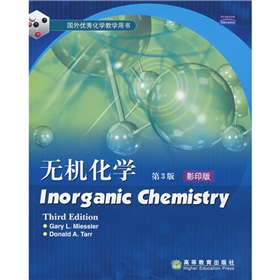国外优秀化学教学用书:无机化学 电子书下载 PDF下载

内容简介
《无机化学》共16章,主要包括无机化学介绍、原子结构、价键理论简介、对称性与群论、分子轨道、酸碱理论、晶体、主族元素、异构体、价键、原子光谱、反应及其机理、有机金属化学、有机金属反应及其机理、主族与有机金属的关联。每章节后有习题,书后有习题解析。并附录常用热力学数据表等内容。
·查看全部>>
目录
PREFACE
1 INTRODUCTION TO INORGANIC CHEMISTRY
1-1 What is Inorganic Chemistry?
1-2 Contrasts with Organic Chemistry
1-3 Genesis of the Elements (The Big Bang)and Flrmation of the Earth
1-4 Nuclear Reactions and Radioactivity
1-5 Distribution of Elements on Earth
1-6 The History of Inorganic Chemistry
2 ATOMIC STRUCTURE
2-1 Historical Development of Atomic Theory
2-1-1 The Periodic Table
2-1-2 Discover of Subatomic Particles and the Bohr Atom
2-2 The Schrodinger Equation
2-2-1 The Particle in a Box
2-2-2 Quantum Numbers and Atomic Wave Functions
2-2-3 The Aufbau Principle
2-2-4 Shielding
2-3 Perildic Properties of Atoms
2-3-1 Ionization Energy
2-3-2 Elecrton Affinity
2-3-3 Covalent and Ionic Radii
3 SIMPLE BONDING THEORY
3-1 Liewis Electron-Dot Diagrams
3-1-1 Resonance
3-1-2 Expanded shells
3-1-3 Formal Charge
3-1-4 Multiple Bonds in Be and B Compounds
3-2 Valence Shell Electron Pair Repulsion Theory
3-2-1 Lone Pair Repulsion
3-2-2 Multiple Bonds
3-2-3 Electroneatuvity and Atomic Size Effects
3-2-4 Ligand Close-Packing
3-3 Polar Molecules
3-4 Hydrogen Bonding
4 SYMMETRY AND GROUP THEORY
4-1 Symmetry Element and Operations
4-2 Point Groups
4-2-1 Groups of Low and High Symmetry
4-2-2 Other Groups
4-3 Properties and Representations of Groups
4-3-1 Matrices
4-3-2 Representations of Point Groups
4-3-3 Character Tables
4-4 Examples and Applications of Symmetry
4-4-1 Chirality
4-4-2 Molecular Vibrations
5 MOLECULAR ORBITALS
5-1 Formation of Molecular Orbiatls form Atomic Orbitals
5-1-1 Molecular Orbitals form s Orbitals
5-1-2 Molecular Orbitals form p Orbitals
5-1-3 Molecular Orbitals form d Orbitals
5-1-4 Nonbonding Orbitals and Other Factors
5-2 Homonuclear Diatomic Molecules
5-2-1 Molecular Orbitals
5-2-2 Orbitals Mixing
5-2-3 First and Second Row Mocecules
5-2-4 Photoelectron Spectroscopy
5-2-5 Correlation Diagrams
5-3 Heteronuclear Diatomic Molecules
5-3-1 Polar Bonds
5-3-2 Ionic Compounds and Molecular Orbiatals
5-4 Molecular Orbitals for Larger Molecules
5-4-1 FHF
5-4-2 CO2
5-4-3 H2O
5-4-4 NH3
5-4-5 BF3
5-4-6 Molecular shapes
5-4-7 Hybrid Orbitals
5-5 Expanded Shells and Molecular Orbitals
6 ACID-BASE AND DONOR-ACCEPTOR CHEMISTRY
6-1 Acid-Base Concepts as Organizing Concepts
6-1-1 History
6-2 Major Acid-Base Concepts
6-2-1 Arrhenius Concept
6-2-2 Brnsted-Lowry Concept
6-2-3 Solvent System Concept
6-2-4 Lewis Concept
6-2-5 Frontier Orbitals and Acid-Base Reactions
6-2-6 Hydrogen Bonding
6-2-7 Electronic Spectra(Including Charge Transfer)
……
7 THE CRYSTALLINE SOLID STATE
8 CHEMISTRY OF THE MAIN GROUP ELEMENTS
9 COORDINATION CHEMISTRYⅠ:STRUSTURES AND ISOMERS
10 COORDINATION CHEMISTRYⅡ:BONDING
11 COORDINATION CHEMISTRYⅢ:ELECTRONIC SPECTRA
12 COORDINATION CHEMISTRYⅣ:REACTIONS AND MECHANISMS
13 ORGANOMETALLIC CHEMISTRY
14 ORGANOMETALLIC REACTONS AND CATALYSIS
15 PARALLELS BETWEEN MAIN GROUP AND ORGANOMETALLIC CHEMISTRY
16 BIOINORGANIC AND ENVIRONMENTAL CHEMISTRY
APPENDIXA ANSWERA TO EXERCISES
APPENDIXA B-1 IONIC RADII
APPENDIXA B-2 IONIZATION ENERGY
APPENDIXA B-3 ELECTORON AFFINITY
APPENDIXA B-4 ELECTRONEGATIVITY
APPENDIXA B-5 ABSOLUTE HARDNESS PARAMETERS
APPENDIXA B-6 CA,EA,CB,AND EB VALUES
APPENDIXA B-7 LATIMER DIAGRAMS FOR SELECTED ELEMENTS
APPENDIXA C CHARACTER TABLES
APPENDIXA ELECTRON-DOT DIAGRAMS AND FORMAL CHARGE
INDEX
1 INTRODUCTION TO INORGANIC CHEMISTRY
1-1 What is Inorganic Chemistry?
1-2 Contrasts with Organic Chemistry
1-3 Genesis of the Elements (The Big Bang)and Flrmation of the Earth
1-4 Nuclear Reactions and Radioactivity
1-5 Distribution of Elements on Earth
1-6 The History of Inorganic Chemistry
2 ATOMIC STRUCTURE
2-1 Historical Development of Atomic Theory
2-1-1 The Periodic Table
2-1-2 Discover of Subatomic Particles and the Bohr Atom
2-2 The Schrodinger Equation
2-2-1 The Particle in a Box
2-2-2 Quantum Numbers and Atomic Wave Functions
2-2-3 The Aufbau Principle
2-2-4 Shielding
2-3 Perildic Properties of Atoms
2-3-1 Ionization Energy
2-3-2 Elecrton Affinity
2-3-3 Covalent and Ionic Radii
3 SIMPLE BONDING THEORY
3-1 Liewis Electron-Dot Diagrams
3-1-1 Resonance
3-1-2 Expanded shells
3-1-3 Formal Charge
3-1-4 Multiple Bonds in Be and B Compounds
3-2 Valence Shell Electron Pair Repulsion Theory
3-2-1 Lone Pair Repulsion
3-2-2 Multiple Bonds
3-2-3 Electroneatuvity and Atomic Size Effects
3-2-4 Ligand Close-Packing
3-3 Polar Molecules
3-4 Hydrogen Bonding
4 SYMMETRY AND GROUP THEORY
4-1 Symmetry Element and Operations
4-2 Point Groups
4-2-1 Groups of Low and High Symmetry
4-2-2 Other Groups
4-3 Properties and Representations of Groups
4-3-1 Matrices
4-3-2 Representations of Point Groups
4-3-3 Character Tables
4-4 Examples and Applications of Symmetry
4-4-1 Chirality
4-4-2 Molecular Vibrations
5 MOLECULAR ORBITALS
5-1 Formation of Molecular Orbiatls form Atomic Orbitals
5-1-1 Molecular Orbitals form s Orbitals
5-1-2 Molecular Orbitals form p Orbitals
5-1-3 Molecular Orbitals form d Orbitals
5-1-4 Nonbonding Orbitals and Other Factors
5-2 Homonuclear Diatomic Molecules
5-2-1 Molecular Orbitals
5-2-2 Orbitals Mixing
5-2-3 First and Second Row Mocecules
5-2-4 Photoelectron Spectroscopy
5-2-5 Correlation Diagrams
5-3 Heteronuclear Diatomic Molecules
5-3-1 Polar Bonds
5-3-2 Ionic Compounds and Molecular Orbiatals
5-4 Molecular Orbitals for Larger Molecules
5-4-1 FHF
5-4-2 CO2
5-4-3 H2O
5-4-4 NH3
5-4-5 BF3
5-4-6 Molecular shapes
5-4-7 Hybrid Orbitals
5-5 Expanded Shells and Molecular Orbitals
6 ACID-BASE AND DONOR-ACCEPTOR CHEMISTRY
6-1 Acid-Base Concepts as Organizing Concepts
6-1-1 History
6-2 Major Acid-Base Concepts
6-2-1 Arrhenius Concept
6-2-2 Brnsted-Lowry Concept
6-2-3 Solvent System Concept
6-2-4 Lewis Concept
6-2-5 Frontier Orbitals and Acid-Base Reactions
6-2-6 Hydrogen Bonding
6-2-7 Electronic Spectra(Including Charge Transfer)
……
7 THE CRYSTALLINE SOLID STATE
8 CHEMISTRY OF THE MAIN GROUP ELEMENTS
9 COORDINATION CHEMISTRYⅠ:STRUSTURES AND ISOMERS
10 COORDINATION CHEMISTRYⅡ:BONDING
11 COORDINATION CHEMISTRYⅢ:ELECTRONIC SPECTRA
12 COORDINATION CHEMISTRYⅣ:REACTIONS AND MECHANISMS
13 ORGANOMETALLIC CHEMISTRY
14 ORGANOMETALLIC REACTONS AND CATALYSIS
15 PARALLELS BETWEEN MAIN GROUP AND ORGANOMETALLIC CHEMISTRY
16 BIOINORGANIC AND ENVIRONMENTAL CHEMISTRY
APPENDIXA ANSWERA TO EXERCISES
APPENDIXA B-1 IONIC RADII
APPENDIXA B-2 IONIZATION ENERGY
APPENDIXA B-3 ELECTORON AFFINITY
APPENDIXA B-4 ELECTRONEGATIVITY
APPENDIXA B-5 ABSOLUTE HARDNESS PARAMETERS
APPENDIXA B-6 CA,EA,CB,AND EB VALUES
APPENDIXA B-7 LATIMER DIAGRAMS FOR SELECTED ELEMENTS
APPENDIXA C CHARACTER TABLES
APPENDIXA ELECTRON-DOT DIAGRAMS AND FORMAL CHARGE
INDEX
同类热门电子书下载更多
Copyright © 2025 by topbester.com.
All Rights Reserved.
沪ICP备14027842号-1
All Rights Reserved.
沪ICP备14027842号-1